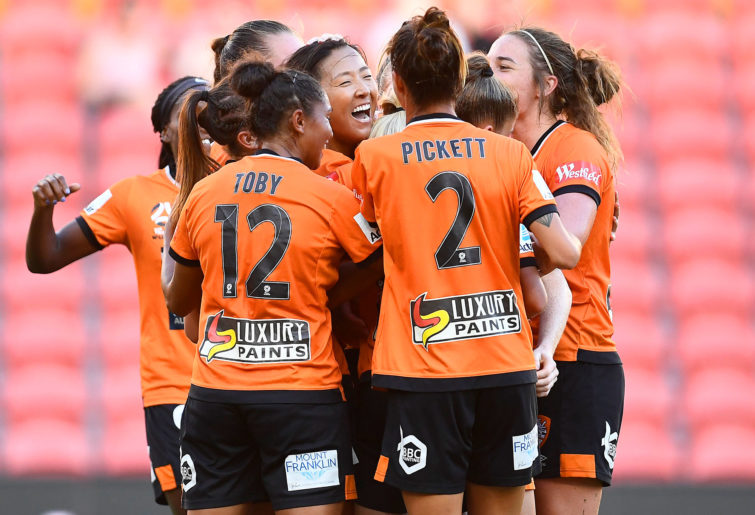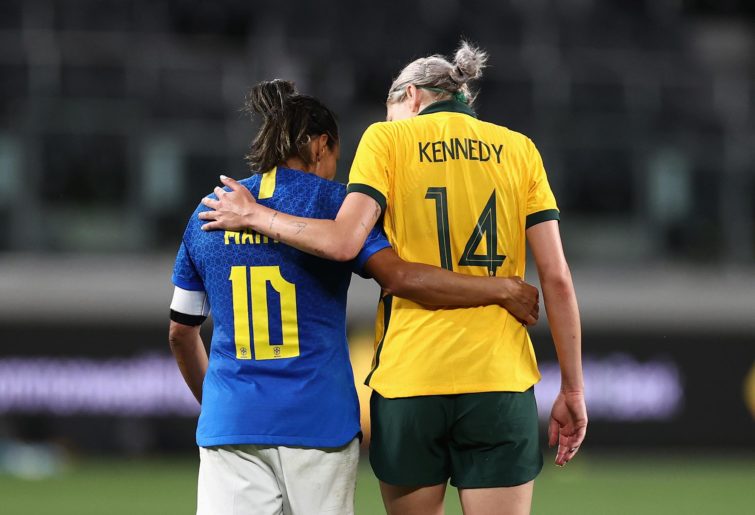Roma are awarded two penalties in Europa League semifinal - but cannot hold on
The two spot kicks levelled the score on aggregate over the two legs, but Bayer Leverkusen then scored two late goals for a draw…
Opinion
As a new era dawns on football in Australia, it is time the women’s game got the respect it deserves. This includes investment from authorities, clubs, sponsors, broadcast networks and, most importantly, fans.
Like it or not, more fans need to start paying their way for women’s football.
Many it is cheap to attend a women’s game and this is fantastic to get fans through the gate and attract sponsors, it is actually a big part of the problem.
The revenue generated by A-League Women teams, while improving, is relatively small. In fact, grants provided to support women’s sport form a major chunk of income generated for A-League Women – for those that get it, that is.
Actual match-day ticketing, merchandise, food and sponsorship revenue remains rather small.
At present, A-League Men memberships generally give free access to women’s games. Essentially this means fans who are club members pay $0 to get in to women’s games.
While many argue the access to women’s games forms part of the value of a membership, the stark reality is the majority of fans buy memberships to support the men’s teams.
To be fair, a decent portion of the membership revenue generated by clubs is then used to cover the expenses of women’s teams.
The cost of running a women’s program is thought to average around $800,000 each year to cover players, coaches, facilities, marketing and other overheads.
Most clubs keep the cost of their women’s programs and revenue generated under wraps. One club, who asked not to be named, claimed they receive $25,000 in sponsorship and only $35,000 in match-day revenue from seven women’s home games.
The average A-League Women’s attendance figures in 2019-20 – the season before COVID – was around 1536. Last season’s average was 1028. Averages peaked at 2122 in 2017-18. This factors in double headers, while standalone averages are much lower.
It is unclear how many of these fans actually use their memberships to get in as opposed to paying at the gate.
Most clubs sell A-League Women standalone memberships, however the take-up is small, partly due to the access given from A-League Men’s memberships.
There is an argument that A-League Men and Women programs should sell separate memberships, with one not giving access to the other. However this goes against the ‘one club’ mentality most are trying to instil in fans.
Clubs also seem to believe this will have a detrimental impact on A-League Women attendance numbers. However, in some ways it may be counter productive to give free access.
Women’s football must be given its chance to prove itself. This is fair enough and comes back to the main point.
We need fans to buy women’s memberships, women’s tickets, women’s merchandise and food while attending women’s games to help generate income.

(Photo by Ian Hitchcock/Getty Images)
We also need clubs and the Australian Professional Leagues (APL) to make games accessible and attractive for fans to attend. The best way to do this is to have decent kick-off times at decent venues.
To make the game attractive we need to enhance the quality of the league by getting marquee players, as we see in the men’s game.
A similar incentive should be provided for women.
In 2019-20, Sam Kerr was apparently paid $400,000 to play for Perth Glory in the W-League, dwarfing the women’s minimum salary of $16,344 and more than doubling the men’s average salary of $180,000 in that season.
While reality means European and American Leagues are going to attract the best players, there is every reason world-class players will come to Australia, where working conditions are of a much higher standard than a lot of European countries.
While the minimum wage sits at only $17,055, the players in Australia generally have good facilities and access to decent hotels when travelling.
With a World Cup coming in 2023, players may want to acclimatise, meaning clubs can leverage this for the next two seasons.
Marketing women’s games is also an important point. The new broadcast arrangement with Channel Ten Bold will see a women’s domestic game broadcast on commercial free-to-air for the first time. The ABC and Foxtel provided decent coverage over the past 13 years, but commercial free-to-air coverage is vital.
Ten is already doing its part, giving tremendous exposure to women’s players on their news bulletins and shows.
Feeding off the popularity of the Matildas is also important. The Matildas vs Brazil games last month at CommBank Stadium attracted 15,000 and 12,000 respectively.
The upcoming two-match series between Australia and the USA is on course to set records at both Stadium Australia in Sydney and McDonald Jones Stadium in Newcastle.

Alanna Kennedy of the Matildas and Marta Vieira Da Silva of Brazil embrace.(Photo by Cameron Spencer/Getty Images)
Nearly 29,000 tickets have been sold for this Saturday’s game in Sydney, as Australian and USA football fans look to break the current Matildas home attendance record of 33,600 fans set during the Sydney 2000 Olympics.
Meanwhile, McDonald Jones Stadium is on track for a sell-out crowd for the first time in Newcastle.
The Matildas attracted TV audiences of over 2 million during two of their games at the recent Tokyo Olympics.
While the disconnect between the Matildas and A-League Women is glaring, with clever marketing and leveraging of future Matildas stars like Courtney Nevin, Kyra Cooney-Cross, Bryleeh Henry, Charlize Rule, Jessika Nash and Remy Siemsen – who still play in Australia – there is no reason why more fans won’t go to domestic games.
By providing an incentive, fans will be more willing to fork out, which will bump up the dollars being brought in, which will provide an incentive for the APL and its clubs to invest more.
It’s about time we all fork out.